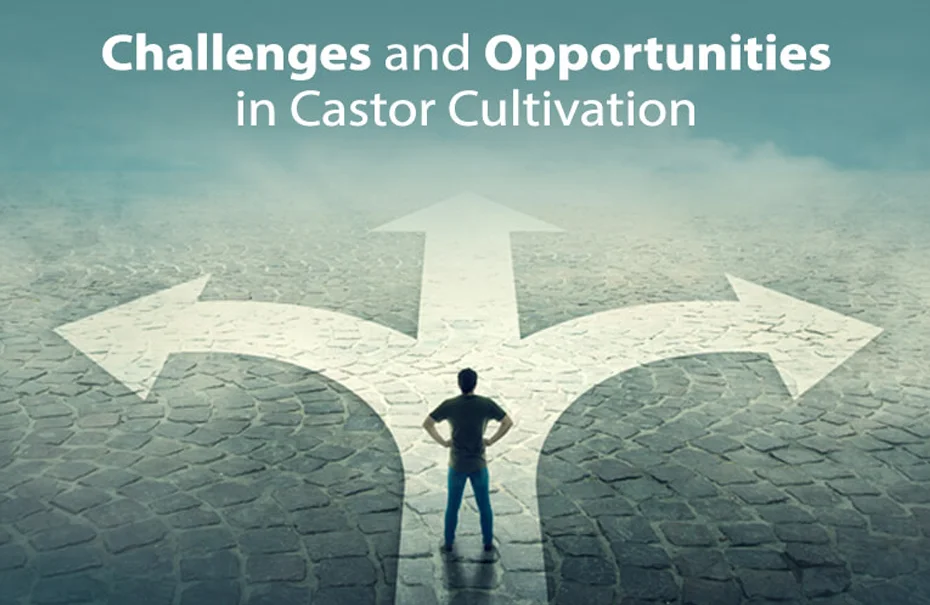Challenges and Opportunities in Castor Cultivation

Introduction
Ricinus communis L. or the castor oil plants are native to tropical Africa is a large plant belonging to the sprurge family of Euphorbiaceae. However, today all the warm countries of the world can grow the crop. The crop yields high volume of oil, which has its uses in the commercial and pharmaceutical industries. Although the plant is the only species in its genus, yet it has several hundreds of natural forms and several horticultural varieties. Although farmers cultivate the castor plants for its rich oil content seeds, which are rich in ricin. The ricin is the most toxic and dangerous substance, and its consumption has fatal outcomes.
Challenges in Castor Cultivation
Varied Yield
Using average quality seeds yield ranges between 2000 to 3000 kg/ha under irrigation and between 700 to 1000 kg/ ha under rain-fed conditions. However, these vary according to the quality of the hybrid seeds used by the farmers. Use of high-yielding variety seeds yields between 4000 to 6000 kg/ ha, under irrigation in Gujarat state of India, which provides all the favorable factors for the growth of castor plants. Besides, the commercially grown varieties of castor produce between 48-50 percent of oil content, out of which the castor oil manufacturers in India can extract 45-46 percent of the oil content. The rest oil content retains with the cake residues.
Storing the Seeds
The farmers do not need to take extensive care of the castor seeds while storing them, as insects and diseases do not attack the seeds. There is no change in the oil production even if the farmers store the seeds for three long years. However, the farmers never store the castor seeds in the warehouse for a long duration. Being a cash crop, the factories immediately crush the seeds for the production of several castor oil derivatives.
Packaging and Shelf Life of Castor Oil
Although castor oil never oxidizes unless exposed to high temperatures, yet the lipid structure of castor oil consists of double bonds, which often experience an undesirable reaction known as lipid oxidation. Lipid oxidation is the result when the double bonds in the fatty acid react with oxygen and form peroxides, changing the chemical nature of the oil. Several factors are responsible for the rate of oxidation in food and other products. The factors include presence of antioxidants, pro-oxidants, radiant energy or visibility of ultraviolet light, oxygen concentration, temperature, free fatty acids versus the corresponding acylglycerols and composition of fatty acids.
Due to the above-mentioned reasons, the manufacturers store the pure castor oil in a controlled environment. The process includes removal or oxygen and storing the oil in a cool place. The manufactures need to store the oil in an opaque container after the removal of pro-oxidants such as cobalt, copper, iron, manganese and nickel. Furthermore, the manufacturers need to add antioxidants.
Toxicity
Castor beans, used for deriving castor oil, contain some allergenic proteins along with ricin. However, the refined castor is free from these substances; hence, it is safe for used in pharmaceutical applications and other castor oil products. Ricin found in the endosperm of the castor seeds and classified as a type 2 ribosome-inactivating protein, which highly affects several large organisms. Ricin derived from the castor beans are lectins that stop synthesis of proteins, causing death to organisms.
Opportunities in Castor Cultivation
As Natural Laxative
Often medical practitioners prescribe castor oil as a natural laxative, which helps in the normal movements of intestinal muscles thereby cleaning the bowel. Using the oil as a stimulant laxative in treating temporary constipation in patients is perhaps the best medical use. When you consume the oil orally, it breaks down in the small intestines and releases RA, stimulating the laxative effect. Practitioners recommend consumption of the oil in very small doses. Because consumption of the oil in large amounts results in nausea, vomiting, diarrhea and other physical ailments.
As Natural Moisturizer
With the richness of RA, a monounsaturated fatty acid, the oil acts as a humectant and moisturizes the skin. The humectants are great retainers of moisture, and prevents water loss from the outer layer of the skin. The lotions, cleansers and make up products containing castor oil are great for use, as they help in locking the moisture of your skin.
As Wound Healer
If you apply castor oil on your wounds, it will create a moist environment, promoting the wound to heal faster. Venelex, a popular ointment used for treating wounds, contains castor oil mixed with Peru Balsam and Myroxylon trees. The oil is also useful for other skin related problems such as dryness, cornification and building of dead skin cells.
In Cancer Research
Although a potent poison, recent studies have stated that ricin possesses antitumor properties, which is beneficial in cancer research and chemotherapy. One of the most promising uses of ricin includes the production of immunotoxins, where the ricin helps in the formation of monoclonal antibodies. These antibodies help in specific target cells of a tumor, thereby destroying the tumor cells without causing damage to other cells of the patient.
Industrial Uses
The hydroxyl functionality of Ricinoleic Acid (RA) makes castor oil a natural polyol, which provides oxidative stability to the oil. Besides, due to the presence of RA, castor oil has a higher shelf life than other oils. RA and RA derivatives provide a functional group location for performing a variety of chemical reactions including halogenation, dehydration, esterification, sulfation and alkylation. The unique functionality allows the use of castor oil in several industrial applications such as paints, coatings, lubricants and inks.
Folk Medicine
In India, people use castor oil as one of the prominent ingredients of folk medicines. People use castor oil in treating ailments like arthritis, asthma, boils, burns, cold, colic, corns, and several other skin diseases.
Paper and Related Products
Recently, people started using the stalk, shell or hull of the castor plants as a low value fuel. Besides, the stalk and the hull found better uses in the paper industry. Hulls or the shells are a good source of carbon, which the paper manufacturers use as an adsorbent in removing colours and impurities.
Conclusion
Although one of the oldest crops, yet the castor oil contributes only 0.15% of the total production of vegetable oils in the world. Due to its commercial source of hydroxyl fatty acid, it has high demand in several industries including chemical, textiles, pharmaceuticals, textile and cosmetic industries. Even though it accounts for 0.15% of global production of vegetable oils, the record of the last 25 years proves that it has the highest demand in the global market.
Ambuja Solvex emerged as one of the best castor oil manufacturers in India, producing both pharmaceutical and industrial grade oils. The firm, without disturbing the unique properties of the plants, derives the oil from them, and delivers the purest form of castor oil for pharmaceutical uses. Besides, the firm holds the highest amount of distribution of its castor oil in various industries in India.



